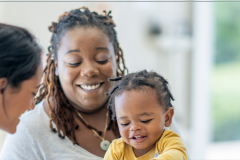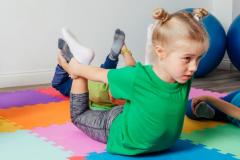- Overview
-
In North America, there are few power mobility devices suitable for young children from one to five years of age. Aesthetics, portability, weight and safety considerations are believed to be important to families of young children. Our current research is exploring family and therapist perceptions of several novel early power mobility devices such as adapted ride-on toys and miniature power wheelchairs. Some families and children will be given the opportunity to borrow this equipment for a six-month loan to explore how this equipment can be integrated into family life and how children benefit. We hope to expand this research into a larger scale loan program in BC that will include ongoing data collection regarding benefits of early power mobility for children and families.
- Publications
-
Commentary on "Quantifying Parental Perceptions of Their Experiences With Their Young Children's Use of Power Mobility Devices"
Pediatric Physical Therapy the Official Publication of the Section on Pediatrics of the American Physical Therapy Association
Livingstone, R.W. and Paleg, G.S. and Erickson, D.C.
DOI: 10.1097/PEP.0000000000001167
2025Standing behaviour of non-ambulant children and youth using powered wheelchair standing devices (PWSDs): an interrupted time series pilot study
Disability and Rehabilitation Assistive Technology
Field, D.A. and Borisoff, J. and Chan, F.H.N. and Livingstone, R.W. and Miller, W.C.
DOI: 10.1080/17483107.2025.2529509
2025Incidence of hip problems in developmental central hypotonia: A scoping review
Developmental Medicine and Child Neurology
Livingstone, R.W. and Paleg, G.S. and Shrader, M.W. and Miller, F. and Rodby-Bousquet, E.
DOI: 10.1111/dmcn.16124
2025Occupational and Physical Therapy Interventions for Young Children with Developmental Central Hypotonia: An Overview of Systematic Reviews
Disabilities
Paleg, G.S. and Hidalgo Robles, ?. and Govender, P. and Livingstone, R.W.
DOI: 10.3390/disabilities5010014
2025Supported standing and stepping device use in young children with cerebral palsy, gross motor function classification system III, IV and V: A descriptive study
Assistive Technology
Livingstone, R.W. and Paleg, G.S. and Field, D.A.
DOI: 10.1080/10400435.2023.2283461
2024Identifying and Evaluating Young Children with Developmental Central Hypotonia: An Overview of Systematic Reviews and Tools
Healthcare (Switzerland)
Hidalgo Robles, ?. and Paleg, G.S. and Livingstone, R.W.
DOI: 10.3390/healthcare12040493
2024Supported Standing and Supported Stepping Devices for Children with Non-Ambulant Cerebral Palsy: An Interdependence and F-Words Focus
International Journal of Environmental Research and Public Health
Paleg, G.S. and Williams, S.A. and Livingstone, R.W.
DOI: 10.3390/ijerph21060669
2024Standing power wheelchairs and their use by children and youth with mobility limitations: an interrupted time series
Disability and Rehabilitation: Assistive Technology
Field, D.A. and Borisoff, J. and Chan, F.H.N. and Livingstone, R.W. and Miller, W.C.
DOI: 10.1080/17483107.2022.2096933
2024Identifying Opportunities for Early Detection of Cerebral Palsy
Children
Hornby, B. and Paleg, G.S. and Williams, S.A. and Hidalgo-Robles, ?. and Livingstone, R.W. and Montufar Wright, P.E. and Taylor, A. and Shrader, M.W.
DOI: 10.3390/children11050515
2024Exploring change in young children’s power mobility skill following several months’ experience
Disability and Rehabilitation: Assistive Technology
Roslyn W. Livingstone and Debra A. Field
DOI: 10.1080/17483107.2020.1847207
04/2023Supported-standing interventions for children and young adults with non-ambulant cerebral palsy: A scoping review
Developmental Medicine and Child Neurology
McLean, L.J. and Paleg, G.S. and Livingstone, R.W.
DOI: 10.1111/dmcn.15435
2023RESNA position on the application of power mobility devices for pediatric users
Assistive Technology
Rosen, L. and Plummer, T. and Sabet, A. and Lange, M.L. and Livingstone, R.
DOI: 10.1080/10400435.2017.1415575
2023Power Mobility, Supported Standing and Stepping Device Use in the First Two Years of Life: A Case Report of Twins Functioning at GMFCS V
Disabilities
Livingstone, R.W. and Chin, A.J. and Paleg, G.S.
DOI: 10.3390/disabilities3040032
2023Use of Overground Supported-Stepping Devices for Non-Ambulant Children, Adolescents, and Adults with Cerebral Palsy: A Scoping Review
Disabilities
Livingstone, R.W. and Paleg, G.S.
DOI: 10.3390/disabilities3020012
2023Beginning power mobility: parent and therapist perspectives
Disability and Rehabilitation
Roslyn Livingstone and Debra Field and Colleen Sanderson and Nicole Pineau and Jill G. Zwicker
DOI: 10.1080/09638288.2020.1842916
06/2022Parents’ and Therapists’ Satisfaction with Four Early Childhood Power Mobility Devices,Satisfaction des parents et des thérapeutes à l'égard de quatre dispositifs d'aide à la mobilité motorisés pour jeunes enfants
Canadian Journal of Occupational Therapy
Field, D.A. and Livingstone, R.W.
DOI: 10.1177/00084174221098879
2022Evidence-informed clinical perspectives on postural management for hip health in children and adults with non-ambulant cerebral palsy
Journal of Pediatric Rehabilitation Medicine
Paleg, G. and Livingstone, R.
DOI: 10.3233/PRM-220002
2022Exploring young children’s activity and participation change following 6 months’ power mobility experience
British Journal of Occupational Therapy
Roslyn W Livingstone and Debra A Field
DOI: 10.1177/0308022620973935
11/2021Enhancing Function, Fun and Participation with Assistive Devices, Adaptive Positioning, and Augmented Mobility for Young Children with Infantile-Onset Spinal Muscular Atrophy: A Scoping Review and Illustrative Case Report
Disabilities
Roslyn Livingstone and Ginny Paleg
DOI: 10.3390/disabilities1010001
01/2021Beginning power mobility: An exploration of factors associated with child use of early power mobility devices and parent device preference
Journal of Rehabilitation and Assistive Technologies Engineering
Roslyn W Livingstone and Jeffrey Bone and Debra A Field
DOI: 10.1177/2055668320926046
01/2020American and Canadian therapists’ perspectives of age and cognitive skills for paediatric power mobility: a qualitative study
Disability and Rehabilitation: Assistive Technology
Kenyon, L.K. and Jones, M. and Breaux, B. and Tsotsoros, J. and Gardner, T. and Livingstone, R.
DOI: 10.1080/17483107.2019.1606858
2020Power mobility skill progression for children and adolescents: a systematic review of measures and their clinical application
Developmental Medicine and Child Neurology
Field, D.A. and Livingstone, R.W.
DOI: 10.1111/dmcn.13709
2018Power mobility for children: a survey study of American and Canadian therapists’ perspectives and practices
Developmental Medicine and Child Neurology
Kenyon, L.K. and Jones, M. and Livingstone, R. and Breaux, B. and Tsotsoros, J. and Williams, K.M.
DOI: 10.1111/dmcn.13960
2018Interventions to improve sensory and motor outcomes for young children with central hypotonia: A systematic review
Journal of Pediatric Rehabilitation Medicine
Paleg, G. and Romness, M. and Livingstone, R.
DOI: 10.3233/PRM-170507
2018Commentary on "ride-On Car Training for Behavioral Changes in Mobility and Socialization among Young Children with Disabilities"
Pediatric Physical Therapy
Paleg, G. and Livingstone, R.
DOI: 10.1097/PEP.0000000000000401
2017Measuring Outcomes for Children with Cerebral Palsy Who Use Gait Trainers
Technologies
DOI: 10.3390/technologies4030022
08/2016Physical risk factors influencing wheeled mobility in children with cerebral palsy: A cross-sectional study
BMC Pediatrics
Rodby-Bousquet, E. and Paleg, G. and Casey, J. and Wizert, A. and Livingstone, R.
DOI: 10.1186/s12887-016-0707-6
2016Evidence-informed clinical perspectives on selecting gait trainer features for children with cerebral palsy
International Journal of Therapy and Rehabilitation
Paleg, G. and Livingstone, R.
DOI: 10.12968/ijtr.2016.23.9.444
2016Comparison of the inertial properties and forces required to initiate movement for three gait trainers
Assistive Technology
Paleg, G. and Huang, M. and Vasquez Gabela, S.C. and Sprigle, S. and Livingstone, R.
DOI: 10.1080/10400435.2015.1123780
2016Facilitating interprofessional evidence-based practice in paediatric rehabilitation: Development, implementation and evaluation of an online toolkit for health professionals
Disability and Rehabilitation
Glegg, S.M.N. and Livingstone, R. and Montgomery, I.
DOI: 10.3109/09638288.2015.1041616
2016Systematic review and clinical recommendations for dosage of supported home-based standing programs for adults with stroke, spinal cord injury and other neurological conditions
BMC Musculoskeletal Disorders
Paleg, G. and Livingstone, R.
DOI: 10.1186/s12891-015-0813-x
2015The child and family experience of power mobility: A qualitative synthesis
Developmental Medicine and Child Neurology
Livingstone, R. and Field, D.
DOI: 10.1111/dmcn.12633
2015Outcomes of gait trainer use in home and school settings for children with motor impairments: A systematic review
Clinical Rehabilitation
Paleg, G. and Livingstone, R.
DOI: 10.1177/0269215514565947
2015Practice considerations for the introduction and use of power mobility for children
Developmental Medicine and Child Neurology
Livingstone, R. and Paleg, G.
DOI: 10.1111/dmcn.12245
2014Systematic review of power mobility outcomes for infants, children and adolescents with mobility limitations
Clinical Rehabilitation
Livingstone, R. and Field, D.
DOI: 10.1177/0269215514531262
2014Clinical tools that measure sitting posture, seated postural control or functional abilities in children with motor impairments: A systematic review
Clinical Rehabilitation
Field, D. and Livingstone, R.
DOI: 10.1177/0269215513488122
2013Facilitating child participation through power mobility
British Journal of Occupational Therapy
Casey, J. and Paleg, G. and Livingstone, R.
DOI: 10.4276/030802213X13627524435306
2013A critical review of powered mobility assessment and training for children
Disability and Rehabilitation: Assistive Technology
Livingstone, R.
DOI: 10.3109/17483107.2010.496097
2010Beginning power mobility: A knowledge translation activity
Occupational Therapy Now
Livingstone, R.
2009 - Research
-
Current Projects
Phase 1: Beginning Power Mobility. This study involves a cross-sectional, observational design wherein the relationships of measures from the child’s profile, environmental setting, physical location, therapy context, family attitudes and goals for power mobility will be described and examined with respect to parental preference of PMD for a longer term trial. ‘Power Mobility Days’ will be offered at locations throughout the province to children below 6 years-of-age with their families and community therapists.
Phase 2: Beginning Power Mobility. This study involves a repeated measures design where 16 children (below 6 years-of-age with mobility limitations) will be offered a 6-month loan of an early PMD (Wizzybug, Bugzi, Tiger cub or modified ride-on toy car). Children will be purposely selected from our Phase 1 study to represent a variety of diagnoses, ages, environmental situations, and types of parent-identified activity and participation goals for use of an early PMD. Measures will be completed at the beginning and end of the loan period.Honours & AwardsProvincial Health Services Authority Plus Award (2015)
Children’s & Women’s Health Centre Education Award (2010)
Provincial Paediatric Recruitment and Retention Council Mentorship Award (2012)
Researching mental health and substance use: Q&A with new investigator Dr. Trevor Goodyear
Dr. Trevor Goodyear's interest in working with youth stems from several years as a registered nurse in Ontario and BC, including in child and adolescent mental health at BC Children's Hospital. He joined BCCHR as an investigator in October 2025.





